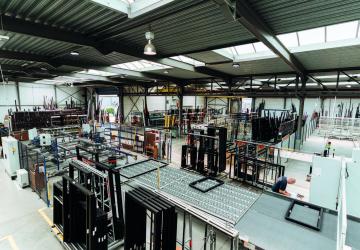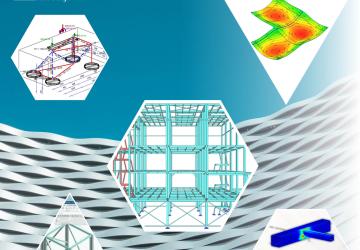As part of our commitment to keeping you informed about the latest industry standards relevant to our software, we're highlighting significant updates to Eurocode 1 (EN 1991-1-2): Actions on structures exposed to fire. The latest version, EN 1991-1-2:2024 (implemented as NEN-EN 1991-1-2:2025 in the Netherlands), introduces changes that could affect your fire safety designs. This article provides a detailed summary of these changes compared to the previous EN 1991-1-2:2002 version, ensuring that you remain compliant and leverage the most up-to-date practices.
Key differences between NEN-EN1991-1-2:2025 and NEN-EN1991-1-2:2002
1. Scope and application (Section 1)
- Clarity of application
The 2025 version provides more explicit guidance on the types of buildings and civil engineering works to which the Eurocode applies (2025: page 10, 1.1(1)). It emphasizes that the fire load should relate directly to the building and its occupancy. - Damage assessment
The 2025 version explicitly states that it does not cover the assessment of structural damage after a fire (2025: page 10, 1.1(4)). This was implicit in the 2002 version (page 10, 1.1(4)) but is now clearly defined. - Supplementary requirements
The 2025 version clarifies that supplementary requirements such as sprinkler systems, occupancy conditions, and approved insulation materials are outside the scope of the Eurocode (2025: page 10, 1.1(5)). These aspects are typically specified by competent authorities.
2. Normative references (Section 2)
- Updated references
The 2025 version includes updated normative references (2025: page 10, Section 2), aligning with the latest versions of other Eurocodes and relevant standards. For example, EN 1990 is now referenced as EN 1990:2023, and EN 1993-1-2 is referenced as EN 1993-1-2:2024. The 2002 version (page 10, 1.2) refers to older, pre-standard (prEN) versions.
3. Terms, definitions and symbols (Section 3)
- Expanded definitions
The 2025 version features a more comprehensive set of terms and definitions (2025: page 11, Section 3), providing greater clarity and reducing ambiguity. For instance, there are new definitions related to design fire scenarios, fire activation risk, and localized fires (2025: page 13-15, 3.1). - Symbol updates
While most symbols remain consistent, some may have been clarified or updated to align with current practices. (2025: page 16, 3.2) and (2002: page 15, 1.6)
4. Structural fire design procedure (Section 4)
- Emphasis on design fire scenarios
The 2025 version places greater emphasis on the selection of relevant design fire scenarios based on a fire risk assessment (2025: page 21, 4.2). This includes considering structures with particular fire risks arising from other accidental actions. - Temperature analysis
The 2025 version provides more specific guidance on temperature analysis of members, including considerations for external members and separating external walls (2025: page 21, 4.4). It clarifies that the temperature analysis duration should match the design fire duration, including the cooling phase for physically based fire models. (2002: page 21, 2.4) - Performance verification
The 2025 version formally introduces the time domain to verify fire resistance (2025: page 22, 4.5(2)). (2002: page 22, 2.5)
5. Thermal action for temperature analysis (Section 5)
- Heat flux calculation
The 2025 version maintains the fundamental approach to calculating net heat flux (2025: page 23, 5.1) but provides more specific details regarding the convective heat transfer coefficient (αc) for different fire curves. - Nominal fire curves
The specifications for standard, external, and hydrocarbon fire curves are largely consistent between the two versions. (2025: page 24, 5.2) and (2002: page 24, 3.2) - Physically based fire models
The 2025 version elaborates on the use of simplified and advanced fire models (2025: page 25, 5.3). It clarifies the parameters to consider and refers to Annexes for detailed calculation methods. (2002: page 25, 3.3)
6. Mechanical actions for structural analysis (Section 6)
- Indirect actions
The 2025 version provides more detailed guidance on assessing indirect fire actions, such as constrained thermal expansion and thermal gradients within members (2025: page 26, 6.1). (2002: page 27, 4.1) - Combination rules
The 2025 version maintains the combination rules for actions from normal temperature design but clarifies the use of quasi-permanent (ψ2,1) or frequent (ψ1,1) values for variable actions (2025: page 27, 6.3). The 2025 version refers to EN 1990:2023 for combination rules whereas the 2002 refers to the general rule (2025: page 27, 6.3.1(1)) and (2002: page 28, 4.3.1(1)).
7. Nationale annexes
- Expanded informative annexes
The 2025 version includes enhanced and reorganized informative annexes, offering detailed calculation methods and guidance on parametric fire curves (2025: page 30, Annex A), external members (2025: page 33, Annex B), localized fires (2025: page 42, Annex C), advanced fire models (2025: page 49, Annex D), fire load densities (2025: page 51, Annex E), equivalent time of fire exposure (2025: page 61, Annex F), configuration factors (2025: page 63, Annex G), and thermal actions for timber structures (2025: page 71, Annex H). (2002: page 30-58, Annex A-G) - Timber structures
A significant addition in the 2025 version is Annex H, which provides guidance on thermal actions for structural fire loads of timber structures (2025: page 71, Annex H). This reflects the increasing use of timber in construction and the need for specific fire safety considerations.
Key takeaways for our software users
- Compliance
Ensure that your designs comply with the latest version of EN 1991-1-2 (NEN-EN 1991-1-2:2025). - Fire risk assessment
Prioritize comprehensive fire risk assessments to define appropriate design fire scenarios. - Advanced modelling
Prioritize comprehensive fire risk assessments to define appropriate design fire scenarios. - Timber structures
Take note of the new guidelines of thermal actions for structural fire loads of timber structures in Annex H when you are using the software for the design of timber structures.
How will our software help?
Our software packages are continually updated to reflect the latest Eurocode standards, and we are working diligently to incorporate the changes introduced in EN 1991-1-2:2024. We will provide updates to help you effectively implement these changes in your projects.
We trust that this summary is helpful. If you have any questions or need further clarification, please don't hesitate to contact our support team.




